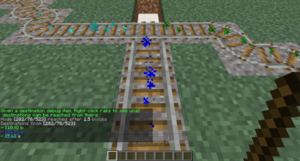/PathFinding
簡介
我們可以通過TC插件的switcher、blocker和destination控制牌的相互配合,實現一個複雜的鐵路系統,讓不同列車前往不同的目的地。在本頁面中將介紹自動尋路系統的工作原理以及配置方式。
TC插件可以在路網中設定路徑點,同時通過列車自身的路徑點屬性將列車導向不同的方向。配置路徑點的信息請參閱此界面。在路網中,道岔以及路徑點的位置被稱為「節點」。為了避免列車衝突,可以使用路阻來限制自動尋路的方向。
配置方法
設定路徑點
首先將destination控制牌放置在軌道下方,在第三行寫上這個路徑點的名稱。第四行可以為經過的列車設置一個新的路徑點(這一行可以留空,列車經過此路徑點之後destination屬性清空)。
設置新的道岔節點
在道岔處放置一個一直激活的switcher控制牌,TC插件會將道岔識別為路網節點。當一列火車駛入道岔時,插件會根據線路情況自動計算出一條路徑,並按照此路徑切換軌道,把列車引導到對應的軌道上。
設置單行線路
When it is desirable that trains only ever go in one direction over a piece of track, an always-powered blocker sign can be used. This is useful when having two tracks side-by-side, each going in opposing directions. The path finding system will automatically ignore paths that are blocked by blocker signs.
來試試吧
Place down a minecart on the track, and use the Destination command to set a destination:
/train destination [name] /train destination output
Now give the minecart a push towards the switcher sign, and observe how it will automatically switch the track to send the train towards the destination. You can change the destination again and send it to the switcher again. Continue to experiment with multiple switchers, blockers and destinations.
If you run into a problem where the switcher appears to make a mistake, use the Reroute command to force a recalculation of all routing information:
/train reroute
It is also possible to use the property sign to set a destination:
高級功能
Once the basic system is understood, there are some more complicated features to discuss.
故障處理
The plugin offers a debug stick with which path finding information can be displayed. Use the stick item to click on rails to show information about the route(s) that can be taken. Sneak (shift) while clicking performs a reroute, which recalculates the track reachable from where you clicked. If you have multiple smaller rail networks, this can be more efficient than executing the global reroute command.
所有路徑點
Use the following command to get a stick item that displays all destinations reached from a given track:
/train debug destination
The track clicked is followed until a node of the track network is found, after which all routeable destinations are listed. For every destination the total distance to it is listed, and particles are displayed leading into it. If you find that a certain destination is not listed that should be, you can move further along the track clicking occasionally to find where the break is.
單一路徑點
Use the following command to debug a specific destination:
/train debug destination [destination]
Now when you click on the track, particles are displayed what route is taken to reach the destination. This is useful when debugging a specific destination so no particles are displayed for routes and destinations that aren't relevant to you.
路徑管理
Normally only one destination is set at a time. It is possible to set the next destination to go to on the destination sign itself, but that means you can only have one possible route. With the route manager a list of destinations to visit can be configured, and then applied to trains. Trains will then go down this list, advancing it every time they pass by a destination on it.
指令
First, edit a train, then use the following commands to set a list of destinations:
/train route set [destination1] ([destination2] [destination3...]) /train route set outpost hillfort dungeon
To add additional destinations to the existing route, or to remove them, use these commands:
/train route add [destination1] ([destination2] [destination3...]) /train route remove [destination1] ([destination2] [destination3...])
You can then use the destination command or property to start the route at a desired destination. Otherwise, the route is started from the beginning the moment the train hits a destination sign. To inspect the route of a train, use the base route command. The current destination the train has is highlighted green.
/train route
Persistence
The route of a train can be saved globally under a name so it can later be applied to other trains instantly.
/train route save [name]
To load a saved route, this command can be used:
/train route load [name]
Alternatively, it can be done using a property sign as well:



![With [+train:left] trains coming from the left are blocked, only allowing movement from right to left. Similarly, [+train:right] and other directions can be used.](/thumb.php?f=Pathfinding_Blocker.png&width=120)



